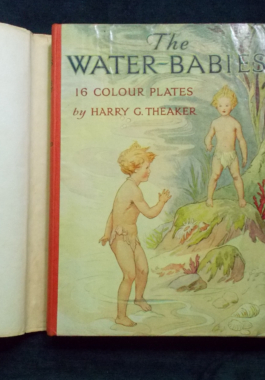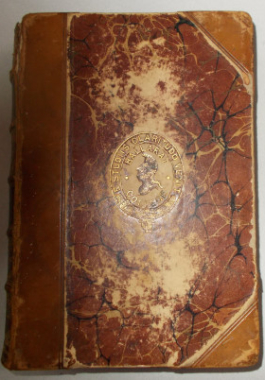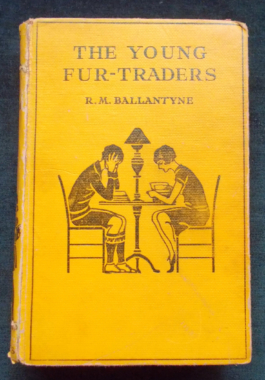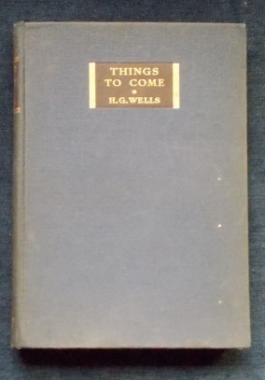-

 The classic children's fantasy adventure that was first published in 1863. Tom, a poor orphan, is employed by the villainous chimney-sweep, Grimes, to climb up inside flues to clear away the soot. While engaged in this dreadful task, he loses his way and emerges in the bedroom of Ellie, the young daughter of the house who mistakes him for a thief. He runs away, and, hot and bothered, he slips into a cooling stream, falls fast asleep, and becomes a water baby. In this new life, he meets all sorts of aquatic creatures, including an engaging old lobster, other water babies, and at last reaches St Branden's Isle where he encounters the fierce Mrs Bedonebyasyoudid and the motherly Mrs Doasyouwouldbedoneby. After a long and arduous quest to the Other-End-Of-Nowhere, Tom achieves his heart's desire. Illustrated by Harry G. Theaker.
The classic children's fantasy adventure that was first published in 1863. Tom, a poor orphan, is employed by the villainous chimney-sweep, Grimes, to climb up inside flues to clear away the soot. While engaged in this dreadful task, he loses his way and emerges in the bedroom of Ellie, the young daughter of the house who mistakes him for a thief. He runs away, and, hot and bothered, he slips into a cooling stream, falls fast asleep, and becomes a water baby. In this new life, he meets all sorts of aquatic creatures, including an engaging old lobster, other water babies, and at last reaches St Branden's Isle where he encounters the fierce Mrs Bedonebyasyoudid and the motherly Mrs Doasyouwouldbedoneby. After a long and arduous quest to the Other-End-Of-Nowhere, Tom achieves his heart's desire. Illustrated by Harry G. Theaker. -
 Written in 1913, this hefty novel commences: "I was an unwanted child - unwanted as a girl at all events. Father Dan Donovan, our parish priest, has told me all about it. I was born in October. It had been raining heavily all day long. The rain was beating hard against the front of our house and running in rivers down the window panes. Towards four in the afternoon the wind rose and then the yellow leaves of the chestnuts in the long drive rustled noisily, and the sea, which is a mile away, moaned like a dog in pain." Mary O'Neill, unwanted by her wealthy father for not being a boy, is married off to an impoverished - yet titled - man. Mary is determined to try and love her husband - she may yet please her father - but then she meets a real gentleman, in every sense of the word, and is torn between her true feelings, duty and her marriage vows.
Written in 1913, this hefty novel commences: "I was an unwanted child - unwanted as a girl at all events. Father Dan Donovan, our parish priest, has told me all about it. I was born in October. It had been raining heavily all day long. The rain was beating hard against the front of our house and running in rivers down the window panes. Towards four in the afternoon the wind rose and then the yellow leaves of the chestnuts in the long drive rustled noisily, and the sea, which is a mile away, moaned like a dog in pain." Mary O'Neill, unwanted by her wealthy father for not being a boy, is married off to an impoverished - yet titled - man. Mary is determined to try and love her husband - she may yet please her father - but then she meets a real gentleman, in every sense of the word, and is torn between her true feelings, duty and her marriage vows. -

 Volume 1 contains some of Poe's better-known and many of his lesser-known tales, including: The Gold-Bug; The Adventure of One Hans Pfaall; The Balloon Hoax; Von Kemelen And His Discovery; Mesmeric Revelation; The Facts In The Case Of M.Valdemar; MS. Found In A Bottle; A Descent Into The Maelstrom; The Black Cat; The Fall Of The House Of Usher; The Pit And The Pendulum; The Thousand-And-Second Tale Of Scheherazade; The Premature Burial; The Masque Of The Red Death; The Cask Of Amontillado; The Imp Of The Perverse; The Island Of The Fay; The Oval Portrait; The Assignation; The Tell-Tale Heart; The Domain Of Arnheim; Landor's Cottage; William Wilson; Berenice; Eleonora; Ligeia; Morella, Metzgengerstein; The Murders In The Rue Morgue; The Mystery Of Marie Roget; The Purloined Letter.
Volume 1 contains some of Poe's better-known and many of his lesser-known tales, including: The Gold-Bug; The Adventure of One Hans Pfaall; The Balloon Hoax; Von Kemelen And His Discovery; Mesmeric Revelation; The Facts In The Case Of M.Valdemar; MS. Found In A Bottle; A Descent Into The Maelstrom; The Black Cat; The Fall Of The House Of Usher; The Pit And The Pendulum; The Thousand-And-Second Tale Of Scheherazade; The Premature Burial; The Masque Of The Red Death; The Cask Of Amontillado; The Imp Of The Perverse; The Island Of The Fay; The Oval Portrait; The Assignation; The Tell-Tale Heart; The Domain Of Arnheim; Landor's Cottage; William Wilson; Berenice; Eleonora; Ligeia; Morella, Metzgengerstein; The Murders In The Rue Morgue; The Mystery Of Marie Roget; The Purloined Letter. -
 The word freak can easily conjure up the image of a squalid Victorian side show exhibit; yet behind the peep-show curtains, the medical textbooks and screaming headlines, these are people who were thrust into a prying, probing limelight because they were different. In this volume: John Merrick, the Elephant Man; Tony Albarran, the Elephant Boy; Maurice Tillet; David Lopez, the 'Devil Boy'; Alice, The Faceless Child; Helen Keller, who possessed the ability of 'eyeless sight'; Matthew Manning, who progressed from bending cutlery and automatic writing to psychic healing; Greta and Freda Chaplin, who spent 20 years in pursuit of the love of a lorry driver; Louise, the Four Legged Woman; Siamese twins Daisy and Violet Hilton, who married and lived with their husbands successfully, as well as featuring in Tod Browning's famous film Freaks; Norman Green, the Human Mole who lived beneath his family's home for eight years unbeknownst to all except his wife; wild children and many more. Black and white photographs.
The word freak can easily conjure up the image of a squalid Victorian side show exhibit; yet behind the peep-show curtains, the medical textbooks and screaming headlines, these are people who were thrust into a prying, probing limelight because they were different. In this volume: John Merrick, the Elephant Man; Tony Albarran, the Elephant Boy; Maurice Tillet; David Lopez, the 'Devil Boy'; Alice, The Faceless Child; Helen Keller, who possessed the ability of 'eyeless sight'; Matthew Manning, who progressed from bending cutlery and automatic writing to psychic healing; Greta and Freda Chaplin, who spent 20 years in pursuit of the love of a lorry driver; Louise, the Four Legged Woman; Siamese twins Daisy and Violet Hilton, who married and lived with their husbands successfully, as well as featuring in Tod Browning's famous film Freaks; Norman Green, the Human Mole who lived beneath his family's home for eight years unbeknownst to all except his wife; wild children and many more. Black and white photographs. -


From the Author's Note: The stories in this volume record happenings in men's lives which interested me during years of wandering among the bushmen and natives of Cape York Pensinsula; the pearlers, trochus and beche-de-mer getters of the Coral Sea; the native islanders of Torres Strait; the beach-combers of the Great Barrier Reef...with two exceptions all are transcripts of fact or are largely based on fact...I hope Colonel Woodman, Bert Vigden of Thursday Island, Bert Jardine of Somerset and others will not mind their names being mentioned. My old mate Dick Welch, I know, will not; neither will "Scandalous" Graham. "Scandalous" may swear a lot and say harsh things about me, then quietly show the book in almost every shearing shed in New South Wales and Queensland, That is, if he's "out of trouble." It doesn't get any better than that!
-
 This is the life of a Canadian trapper in the early 1800s. Charlie Kennedy lives in the arctic colony known as the Red River Settlement with Indians, Scotsmen, and French-Canadian settlers. His father, an old fur trader, hopes to convince his son to become a clerk by recounting the dangers of the trapper’s life, but the stories only inspire the boy more to explore the vast Canadian wilderness. A variety of circumstances lead to Charlie trapping in the vast forests, on a journey with voyagers down perilous rivers, and surviving all sorts of scrapes and adventures with a new acquaintance, Jacques Caradoc, and an Indian named Red Feather. Many of Charlie’s exploits are taken from the real-life experiences of R.M. Ballantyne’s own time with the Hudson Bay Company in Canada. Just as Ballantyne had done, Charlie learns to shoot mercury from his rifle through a two inch board in 39 degree below zero temperatures. Discover the strenuous and vigorous life of a trapper through the eyes of Charlie and his friends.
This is the life of a Canadian trapper in the early 1800s. Charlie Kennedy lives in the arctic colony known as the Red River Settlement with Indians, Scotsmen, and French-Canadian settlers. His father, an old fur trader, hopes to convince his son to become a clerk by recounting the dangers of the trapper’s life, but the stories only inspire the boy more to explore the vast Canadian wilderness. A variety of circumstances lead to Charlie trapping in the vast forests, on a journey with voyagers down perilous rivers, and surviving all sorts of scrapes and adventures with a new acquaintance, Jacques Caradoc, and an Indian named Red Feather. Many of Charlie’s exploits are taken from the real-life experiences of R.M. Ballantyne’s own time with the Hudson Bay Company in Canada. Just as Ballantyne had done, Charlie learns to shoot mercury from his rifle through a two inch board in 39 degree below zero temperatures. Discover the strenuous and vigorous life of a trapper through the eyes of Charlie and his friends. -
 An A-Z of eccentrics and eccentricities for teenagers. Featuring: the artist who exhibited an exploding bull; the Russian admiral who invented the circular battleship; the Duchess who rode through London in a boat on wheels; the Marquis who erected a tombstone to his leg and many more. A real collection of eccentrics, nutters, enthusiasts and ideas-people - and all crazy in the best possible way.
An A-Z of eccentrics and eccentricities for teenagers. Featuring: the artist who exhibited an exploding bull; the Russian admiral who invented the circular battleship; the Duchess who rode through London in a boat on wheels; the Marquis who erected a tombstone to his leg and many more. A real collection of eccentrics, nutters, enthusiasts and ideas-people - and all crazy in the best possible way. -

Things To Come: H.G. Wells
$20.00Wells' own novelisation of the 1935 film inspired by The Shape of Things To Come. When Dr Philip Raven, an intellectual working for the League of Nations, dies in 1930 he leaves behind a powerful legacy - an unpublished 'dream book'. Inspired by visions he has experienced for many years, it appears to be a book written far into the future: a history of humanity from the date of his death up to 2105. The Shape Of Things To Come provides this history of the future, an account that was in some ways remarkably prescient - predicting climatic disaster and sweeping cultural changes, the Second World War, the rise of chemical warfare and political instabilities in the Middle East.



